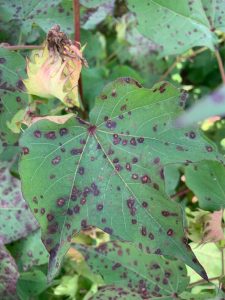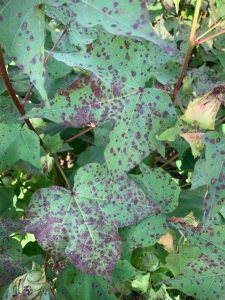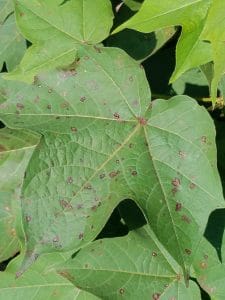For the last couple of weeks I’ve been getting asked about leaf spots in cotton and the majority of them have been leaf spot complex.
Below are some images of leaf spot complex in cotton – one of the main ways to determine it’s leaf spot complex is the location in the canopy – upper and throughout the canopy. It’s called leaf spot complex because there are 3 different pathogens that can cause these spot: Stemphyllium, Cercospora, and Alternaria. The only way to know which pathogen is causing the spots is to look at the spores under a microscope, but the good news – it doesn’t matter.
These are opportunistic pathogens = when the plant is stressed is when they attack. Stress can be from drought, compaction, etc. and the majority of the time it is nutrient deficiency, particularly potassium. The leaf spot complex is easily found later in the season when the plants have such a large boll load they are not able to take up enough potassium.
These pathogens generally will not cause yield loss and do not respond to a fungicide application. Being opportunistic, once the stress on the plant is relieved (i.e. potassium added for next season) little to no leaf spots will be seen. But remember once spots are present they will not disappear. See previous article on news.utcrops.com, Cotton diseases – what to be on the look out for to see additional pictures of diseases in cotton and the mobile friendly field guide (guide.utcrops.com) to better distinguish between leaf spots in cotton.
In contrast to the leaf spot complex, there is some target spot and bacterial blight in cotton. Both of these diseases can cause yield loss, but only target spot will respond to a fungicide application. See previous article, Quick and Dirty about Target Spot in Cotton on news.utcrops.com for more information about target spot and management options.





